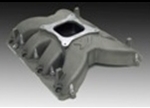

Cameron based the 1970 Challenger grille on an older sketch of a stillborn 1966 Charger prototype that was to have a turbine engine. The exterior design was penned by Carl Cameron, who was also responsible for the exterior designs of the 1966 Dodge Charger. With 1971 being the sole exception, the front ends of both cars differed from each other in that the Challenger had four headlights and the Barracuda had only two a trend replicated by offerings from Chrysler's rivals. Air conditioning and a rear window defogger were optional. The 110 in (2,800 mm) wheelbase was 2 in (51 mm) longer than the Barracuda's, and the Dodge differed substantially in its sheetmetal, much as the Cougar differed from the shorter-wheelbase Mustang. The Challenger's longer wheelbase, larger dimensions, and more luxurious interior were prompted by the launch of the 1967 Mercury Cougar, likewise, a bigger, more luxurious, and more expensive pony car aimed at affluent young American buyers. The first usage of the "challenger" name was for a trim package in 1959 called the Dodge Silver Challenger which was a two-door coupe only. Even so, Chrysler intended the new Challenger as the most potent pony car ever, and like the less expensive Barracuda, it was available in a staggering number of trim and option levels, and with virtually every engine in Chrysler's inventory. Positioned to compete against the Mercury Cougar and Pontiac Firebird in the upper end of the pony car market segment, it was "a rather late response" to the Ford Mustang, which debuted in April 1964. Introduced in fall 1969 for the 1970 model year, the Challenger was one of two Chrysler E-body cars, the other being the slightly smaller Plymouth Barracuda. 3.15 Limited production 3rd party variants.3.7.1 Dodge Challenger 100th Anniversary Edition.In November 2021, Chrysler announced that 2023 would be the final model year for the Challenger, as the company focused future plans on electric rather than gasoline powered vehicles. The third and current generation is a pony car that was introduced in early 2008 originally as a rival to the evolved fifth generation Ford Mustang and the fifth generation Chevrolet Camaro. The second generation, from model years 1978 to 1983, was a badge engineered Mitsubishi Galant Lambda, a coupe version of an economical compact car. However, the first use of the Challenger name by Dodge was in 1959 for marketing a "value version" of the full-sized Coronet Silver Challenger.įrom model years 1970 to 1974, the first generation Dodge Challenger pony car was built using the Chrysler E platform in hardtop and convertible body styles sharing major components with the Plymouth Barracuda. Power from headers is less about absolute flow through the tubes-though that too must be sufficient-and more about the effective manipulation of these pressure waves.The Dodge Challenger is the name of three different generations of automobiles (two of those being pony cars) produced by American automobile manufacturer Dodge. Stock manifolds do not do this, as the short lengths would be tuned for extremely high rpm. At lower engine speeds, the negative pressure waves have sufficient time to arrive at the combustion chamber in time to help enhance cylinder filling. The reason for this is that the reflected waves must travel the length of the primary tubes.

The longer the primary tubes, the more effective they are at lower engine speeds.

Much like the positive pressure waves that are created by intake runner length, exhaust primary tube length determines the effective operating rpm of the headers. The long primary tubes in exhaust headers create a scavenging effect through negative pressure waves. The reality is that nothing could be further from the truth. Many people think that the shorter factory manifolds offer more low-speed torque. Before getting to the results, it's important to make the following point.


 0 kommentar(er)
0 kommentar(er)
